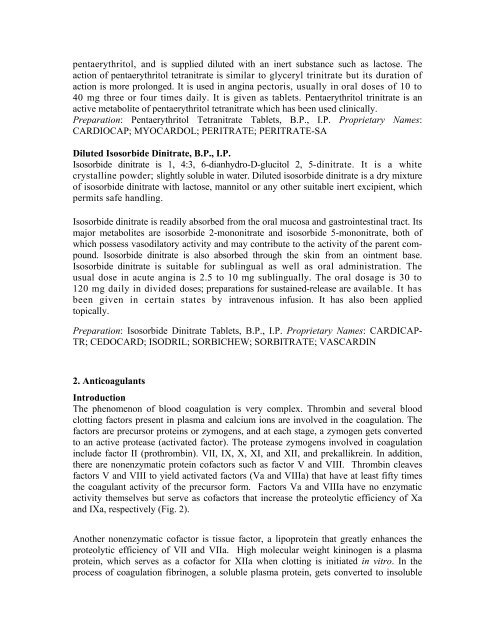MEDICINAL CHEMISTRY
MEDICINAL CHEMISTRY
MEDICINAL CHEMISTRY
You also want an ePaper? Increase the reach of your titles
YUMPU automatically turns print PDFs into web optimized ePapers that Google loves.
pentaerythritol, and is supplied diluted with an inert substance such as lactose. The<br />
action of pentaerythritol tetranitrate is similar to glyceryl trinitrate but its duration of<br />
action is more prolonged. It is used in angina pectoris, usually in oral doses of 10 to<br />
40 mg three or four times daily. It is given as tablets. Pentaerythritol trinitrate is an<br />
active metabolite of pentaerythritol tetranitrate which has been used clinically.<br />
Preparation: Pentaerythritol Tetranitrate Tablets, B.P., I.P. Proprietary Names:<br />
CARDIOCAP; MYOCARDOL; PERITRATE; PERITRATE-SA<br />
Diluted Isosorbide Dinitrate, B.P., I.P.<br />
Isosorbide dinitrate is 1, 4:3, 6-dianhydro-D-glucitol 2, 5-dinitrate. It is a white<br />
crystalline powder; slightly soluble in water. Diluted isosorbide dinitrate is a dry mixture<br />
of isosorbide dinitrate with lactose, mannitol or any other suitable inert excipient, which<br />
permits safe handling.<br />
Isosorbide dinitrate is readily absorbed from the oral mucosa and gastrointestinal tract. Its<br />
major metabolites are isosorbide 2-mononitrate and isosorbide 5-mononitrate, both of<br />
which possess vasodilatory activity and may contribute to the activity of the parent compound.<br />
Isosorbide dinitrate is also absorbed through the skin from an ointment base.<br />
Isosorbide dinitrate is suitable for sublingual as well as oral administration. The<br />
usual dose in acute angina is 2.5 to 10 mg sublingually. The oral dosage is 30 to<br />
120 mg daily in divided doses; preparations for sustained-release are available. It has<br />
been given in certain states by intravenous infusion. It has also been applied<br />
topically.<br />
Preparation: Isosorbide Dinitrate Tablets, B.P., I.P. Proprietary Names: CARDICAP-<br />
TR; CEDOCARD; ISODRIL; SORBICHEW; SORBITRATE; VASCARDIN<br />
2. Anticoagulants<br />
Introduction<br />
The phenomenon of blood coagulation is very complex. Thrombin and several blood<br />
clotting factors present in plasma and calcium ions are involved in the coagulation. The<br />
factors are precursor proteins or zymogens, and at each stage, a zymogen gets converted<br />
to an active protease (activated factor). The protease zymogens involved in coagulation<br />
include factor II (prothrombin). VII, IX, X, XI, and XII, and prekallikrein. In addition,<br />
there are nonenzymatic protein cofactors such as factor V and VIII. Thrombin cleaves<br />
factors V and VIII to yield activated factors (Va and VIIIa) that have at least fifty times<br />
the coagulant activity of the precursor form. Factors Va and VIIIa have no enzymatic<br />
activity themselves but serve as cofactors that increase the proteolytic efficiency of Xa<br />
and IXa, respectively (Fig. 2).<br />
Another nonenzymatic cofactor is tissue factor, a lipoprotein that greatly enhances the<br />
proteolytic efficiency of VII and VIIa. High molecular weight kininogen is a plasma<br />
protein, which serves as a cofactor for XIIa when clotting is initiated in vitro. In the<br />
process of coagulation fibrinogen, a soluble plasma protein, gets converted to insoluble

















